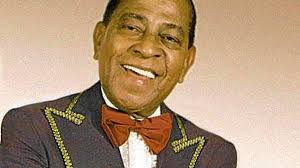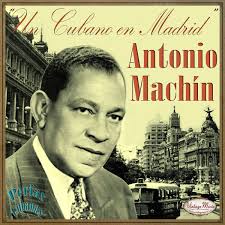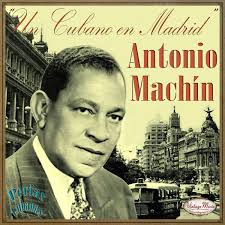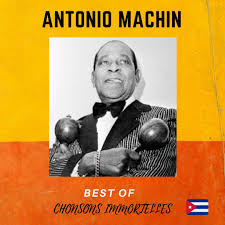
Antonio Abad Lugo Machín fue un cantante y músico hispano-cubano. En España sus canciones forman parte de la memoria sentimental de varias generaciones. Machín era conocido además como el más cubano de los españoles.
El popular bolerista nació en Sagua La Grande el 11 de febrero de 1903 y murió en España, donde vivió 58 años, el cuatro de agosto de 1977.
Su versión de El Manisero, grabada en Nueva York en 1930 con la orquesta de Don Azpiazú, fue la primera de un artista cubano en vender un millón de discos. Aunque se la catalogó como rumba, en realidad era un son pregón, es decir, una canción basada en el pregón de un vendedor ambulante.
BIOGRAFIA
Machín era hijo mestizo de Leoncia Machín, cubana, y José Lugo Padrón, español, emigrante a Cuba desde Galicia. Machín fue uno de dieciséis hijos. Sus primeros años fueron difíciles: a los ocho años se vio obligado a trabajar para ayudar a pagar algunas de las numerosas deudas de su padre.
Un día, estaba en la calle, junto a su casa, cantando en voz baja. Un sacerdote que pasaba por allí lo oyó y de inmediato lo animó a cantar en una fiesta. Cantó el Ave María de Schubert. Desde ese día, Machín se propuso ser cantante. Su ambición era cantar ópera, pero a principios del siglo XX esto era difícil para un cubano de color y con pocos recursos. Por ello, se centró en la música popular.
A los veinte años se había convertido en el ídolo de las jóvenes de su barrio. Machín les cantaba serenatas a la luz de la luna. Trabajó como albañil y también viajó por Cuba como cantante. En 1926 se mudó a La Habana, donde conoció a un español que le ayudó a conseguir un contrato para cantar en un pequeño café habanero.
En La Habana, Machín conoció diversos géneros musicales. Formó parte de varios tríos, cuartetos y sextetos. En 1924, formó un dúo con el trovador Miguel Zaballa. Posteriormente, se unió al Trío Luna, con Enrique Peláez y Manuel Luna. En 1926 se incorporó a la orquesta de Don Azpiazú, la banda del Casino de La Habana. En 1930 viajó a Nueva York con la orquesta de Don Azpiazú, donde grabó El manisero (El manisero, escrita por Moisés Simons). Se convirtió en la primera canción cubana en alcanzar el éxito en Estados Unidos, presagiando el auge de la rumba en la década de 1930.
Machín no regresó a Cuba después de esta gira, estableciéndose temporalmente en Nueva York.
En Nueva York, Machín grabó aproximadamente 200 temas y formó el Cuarteto Machín en 1932. Los otros miembros eran los puertorriqueños Plácido Acevedo (trompeta), Cándido Vicenty (tres) y Daniel Sánchez (segunda voz y guitarra). El propio Machín era la primera voz. Varios otros músicos lo sustituyeron según fue necesario, y finalmente se convirtió en el Sexteto Machín, con el gran trompetista cubano Remberto Lara, a quien Mario Bauzá sustituyó en algunas grabaciones.
Machín cantó con otras agrupaciones como José Escarpenter y su Orquesta, la Orquesta Antillana de Rafael Hernández, Julio Roque y su Orquesta, y Armando Valldespí y su Orquesta, además de actuar con la Orquesta Machín y el Cuarteto Machín.
SU VIAJE A EUROPA
En 1935 se trasladó a Europa, residiendo en Londres y París antes de establecerse en Madrid a finales de la década de 1930, donde permanecería hasta su fallecimiento. En París, formó Antonio Machín y su Orquesta, con Simons al piano, y continuó grabando en la ciudad (donde la música cubana había sido popular desde finales de los años veinte). Tras mudarse a Madrid, se casó con María de los Ángeles Rodríguez, de Sevilla, en 1943.
Con el Cuarteto Machín, realizó más de 60 grabaciones en España, a menudo grabando obras de los compositores Oswaldo Farrés y Consuelo Velázquez. También tuvo una extensa carrera discográfica cantando con diversas bandas españolas; el total de grabaciones en Europa podría ascender a cuatrocientas, lo que le da un total de alrededor de 600 temas grabados a lo largo de su vida. Si esto es aproximadamente cierto, sería uno de los cantantes cubanos más grabados del siglo XX, solo superado por Celia Cruz.

Es conocido principalmente por interpretar El Manisero, Dos gardenias, Madrecita y Angelitos negros.
Machin empezó prácticamente desde abajo y llegó a ser testigo y banda sonora de las historias de amor de los españoles en tiempos difíciles y su popularidad fue creciendo hasta ser idolatrado como lo eran las grandes estrellas de la copla.
Sus canciones pasaron a ser parte de la memoria sentimental de varias generaciones en su segunda patria a través de la radio y hasta entró en el refranero popular español con el dicho «Te mueves más que las maracas de Machín».
En Alcalá de Guadaíras (Sevilla) el siete de junio de 1977, protagonizó su última actuación en público.
Falleció en Madrid el 4 de Agosto de 1977 y fue enterrado en el Cementerio de San Fernando de Sevilla. Hoy día sus compatriotas y familiares lo recuerdan cada año rociando su tumba con ron cubano y cantando alguno de sus boleros.
En 2002 Nuria Villazán dirigió la Coproducción España-Cuba; Iroko Films, Canal 9 Televisión Valenciana, Canal Sur, Escuela Internacional de Cine y Televisión, titulado Machín: Toda una vida, en homenaje póstumo al gran bolerista.


ANTONIO MACHÍN, A POPULAR BOLERO PERFORMER AND KNOWN AS THE “MOST SPANISH OF CUBANS.” PHOTOS.
Antonio Abad Lugo Machín was a Spanish-Cuban singer and musician. In Spain, his songs are part of the sentimental memories of several generations. Machín was also known as the most Cuban of Spaniards.
The popular bolero singer was born in Sagua La Grande on February 11, 1903, and died in Spain, where he lived for 58 years, on August 4, 1977.
His version of El Manisero, recorded in New York in 1930 with Don Azpiazú’s orchestra, was the first by a Cuban artist to sell a million records. Although it was classified as a rumba, it was actually a son pregón, that is, a song based on a street vendor’s cry.
BIOGRAPHY
Machín was the mixed-race son of Leoncia Machín, a Cuban, and José Lugo Padrón, a Spaniard who emigrated to Cuba from Galicia. Machín was one of sixteen children. His early years were difficult: at the age of eight, he was forced to work to help pay off some of his father’s numerous debts.
One day, he was standing on the street outside his house, singing softly. A priest passing by heard him and immediately encouraged him to sing at a party. He sang Schubert’s Ave Maria. From that day on, Machín was determined to become a singer. His ambition was to sing opera, but at the beginning of the 20th century, this was difficult for a Black Cuban with few resources. So, he focused on popular music.
By the age of twenty, he had become the idol of the young women in his neighborhood. Machín would sing serenades for them in the moonlight. He worked as a bricklayer and also traveled around Cuba as a singer. In 1926, he moved to Havana, where he met a Spaniard who helped him get a contract to sing in a small Havana café.
In Havana, Machín was introduced to various musical genres. He was part of several trios, quartets, and sextets. In 1924, he formed a duo with troubadour Miguel Zaballa. Later, he joined the Trio Luna, with Enrique Peláez and Manuel Luna. In 1926, he joined Don Azpiazú’s orchestra, the band at the Havana Casino. In 1930, he traveled to New York with Don Azpiazú’s orchestra, where he recorded “El manisero” (The Peanut Vendor, written by Moisés Simons). It became the first Cuban song to achieve success in the United States, heralding the rise of rumba in the 1930s.
Machín did not return to Cuba after this tour, settling temporarily in New York.
In New York, Machín recorded approximately 200 songs and formed the Machín Cuarteto in 1932. The other members were Puerto Ricans Plácido Acevedo (trumpet), Cándido Vicenty (tres), and Daniel Sánchez (backing vocals and guitar). Machín himself was the lead vocalist. Various other musicians replaced him as needed, and it eventually became the Machín Sexteto, featuring the great Cuban trumpeter Remberto Lara, whom Mario Bauzá replaced on some recordings.
Machin sang with other groups such as José Escarpenter and his Orchestra, Rafael Hernández’s Antillana Orchestra, Julio Roque and his Orchestra, and Armando Valldespí and his Orchestra, in addition to performing with the Machín Orchestra and the Machín Cuarteto.
HIS JOURNEY TO EUROPE
In 1935, he moved to Europe, living in London and Paris before settling in Madrid in the late 1930s, where he would remain until his death. In Paris, he formed Antonio Machín and his Orchestra, with Simons on piano, and continued recording in the city (where Cuban music had been popular since the late 1920s). After moving to Madrid, he married María de los Ángeles Rodríguez, from Seville, in 1943.
With the Machín Quartet, he made more than 60 recordings in Spain, often recording works by composers Oswaldo Farrés and Consuelo Velázquez. He also had an extensive recording career singing with various Spanish bands; his total recordings in Europe could amount to 400, giving him a lifetime total of around 600 songs. If this is approximately true, he would be one of the most recorded Cuban singers of the 20th century, surpassed only by Celia Cruz.
He is best known for his performances of El Manisero, Dos Gardenias, Madrecita, and Angelitos Negros.
Machin started practically from the bottom and became a witness and soundtrack to the love stories of Spaniards in difficult times. His popularity grew until he was idolized like the great stars of copla.
His songs became part of the sentimental memories of several generations in his second homeland through radio and even entered Spanish popular sayings with the saying “Te movers más que las maracas de Machín.”
In Alcalá de Guadaíras (Seville), on June 7, 1977, he gave his last public performance.
He died in Madrid on August 4, 1977, and was buried in the San Fernando Cemetery in Seville. Today, his compatriots and family remember him every year by sprinkling his grave with Cuban rum and singing one of his boleros.
In 2002, Nuria Villazán directed the Spain-Cuba co-production with Iroko Films, Canal 9 Televisión Valenciana, Canal Sur, and the International School of Film and Television, entitled Machín: A Whole Life, a posthumous tribute to the great bolero singer.

Agencies/ Wiki/ Arrajatabla/ Alberto Denis/ El Mundo/ República.com/ Extractos/ Excerpts/ Internet Photos./ Arnoldo Varona.
www.TheCubanHistory.com
THE CUBAN HISTORY, HOLLYWOOD.





